At Home
World War I brought new defense industries to the state. These industries employed thousands of Tennesseans.
In Millington, Tennessee, Park Field became a military training site for air pilots during the War.
The Dupont plant at Old Hickory, outside of Nashville, was the largest wartime producer of gunpowder in the world. The plant eventually brought in more than 20,000 new workers. These workers created a need for housing in the town and larger sanitation facilities.
Tennessee women also contributed to the war effort both abroad and domestically as nurses and workers.
More than 66,000 women registered for various employment opportunities connected to the war effort. The Old Hickory plant offered well-paying jobs for women.
Other war-related jobs for women included private agencies such as the Young Women’s Christian Association, the American Red Cross, and the state and city Liberty Loan Organizations. Every loan drive to raise money for the war was sold out in Tennessee.
Home Demonstration Clubs promoted efficient production of food at home and wartime food drives. State extension agents who worked with these clubs held classes on food conservation and gave out recipes for meatless and sugarless days.
When the war ended, people wanted to celebrate. There were homecoming parades, block dances, and banquets. There was a Knoxville parade that drew more than 30,000, while in Nashville a parade at Centennial Park had more than 100,000 people. In Middle Tennessee, one homecoming dinner collected 10,000 cakes from cake makers. A committee of black citizens in Jackson planned a celebration for returning African American soldiers.
The legislature voted a monetary bonus for all Tennesseans who had served in the war. Memorials were erected in many areas including the War Memorial Building in Nashville. It is estimated that as many as 130,915 Tennesseans served in the war with 3,836 deaths and 6,190 casualties .Picture Credits:
- Photograph showing a parade for World War I African American draftees. This parade takes place on September 1, 1918 in Memphis. The caption below the photo reads, “An enthusiastic audience of 20,000 people who bade farewell to over 1300 jolly Colored draftees at Memphis, Tennessee, Sept. 1, 1918.” This photo was originally included in The Negro Pictorial Review; a visual narrative of the Negro’s glorious part in the world’s greatest war. Of the Great War, by M. V. Lynk and published in 1917. New York Public Library.
- Photograph showing Red Cross Headquarters in Memphis. The photo shows African American Red Cross workers sewing. The caption reads, “Headquarters “Solvent Branch”, Red Cross headquarters, Memphis, Tennessee; They made many thousands of articles for our boys in France.” This photo was originally included in The Negro Pictorial Review; a visual narrative of the Negro’s glorious part in the world’s greatest war. Of the Great War, by M. V. Lynk and published in 1917. New York Public Library.
- Photograph of World War I veterans nurses. This photo was taken at a hospital in Johnson City, Tennessee. The women are shown in their white nurses uniforms standing in front of a building. Tennessee State Museum Collection, 2005.117.24.
- Photograph showing veterans and nurses in a hospital ward. The photo shows the interior of a hospital in Johnson City, Tennessee. Men are shown in their beds or seated in chairs. A doctor is also visible along with the numerous beds, desks, chairs, and cabinets. Tennessee State Museum Collection, 2005.3117.23.
- Photograph showing the 30th Division welcome home parade. The parade takes place on Market Street on April 8, 1919 in Chattanooga. Chattanooga-Hamilton County Bicentennial Library.
- Photograph showing a victory parade after Armistice Day on Franklin Street in Clarksville, Tennessee. This photo was taken on May 15, 1919, and shows locals watching members of the Student Army Training Corps from Southwestern Presbyterian University march. Troops would not return from overseas and training camps until months after the parade. Austin Peay State University.
- Photograph showing a victory garden. The photo shows Mrs. J. H. Matthews displaying her victory garden of produce and canned goods. Matthews won fourteen ribbons at the Tennessee State Fair War Exhibit and very active in the Victory Garden Association. Americans were encouraged to start gardens during World War I to help with the war effort by not purchasing commercial food, which was used to supply United States troops. Nashville Public Library.
- Photograph entitled, “Soldiers dancing in the street.” The photo was taken on April 3, 1919 and shows soldiers dancing on Broad Street in Chattanooga. This street dance was probably part of the welcome home celebrations for the returning soldiers of the 30th Division. Chattanooga-Hamilton County Bicentennial Library.
- Photograph of World War I soldiers in Nashville. The photo was taken in 1918 and shows six soldiers are standing in front of a tent in the city’s railroad gulch. Nashville Public Library.
- Photograph showing the YMCA building at the Old Hickory Powder Plant in Old Hickory, Tennessee. This photo was taken in 1918 or 1919 and shows a large group of men, who are probably employees at the plant. Tennessee State Library and Archive.
Confronting the Modern Era >> Tennesseans at War >> World War I >> At Home
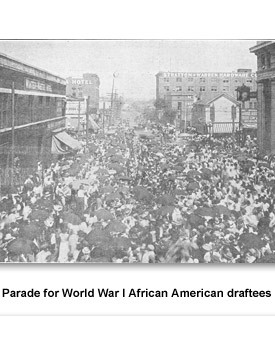
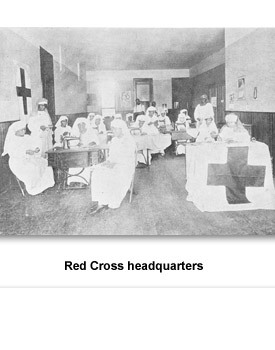
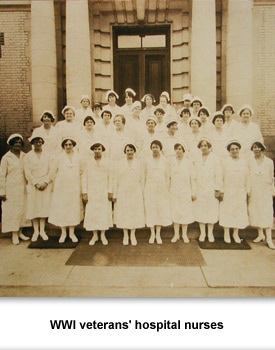
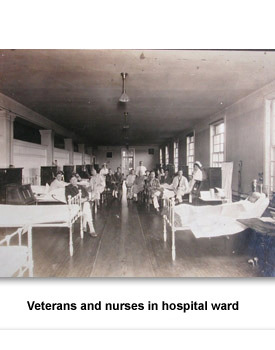
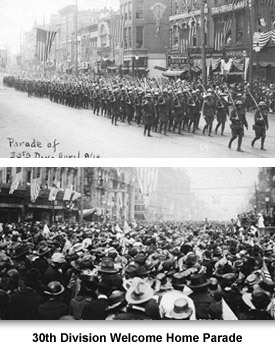
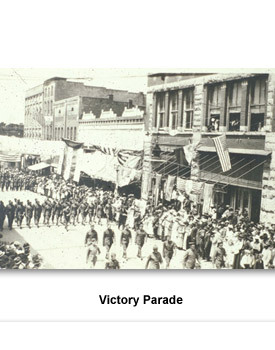
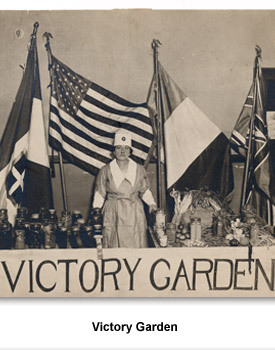
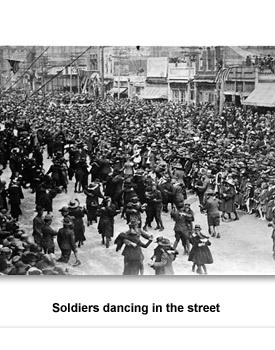
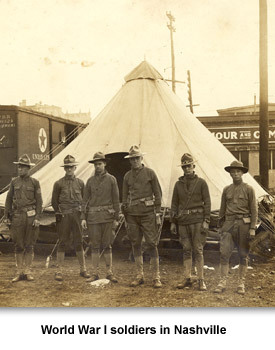
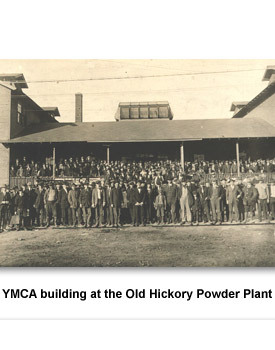
 Sponsored by: National Endowment for the Humanities
Sponsored by: National Endowment for the Humanities